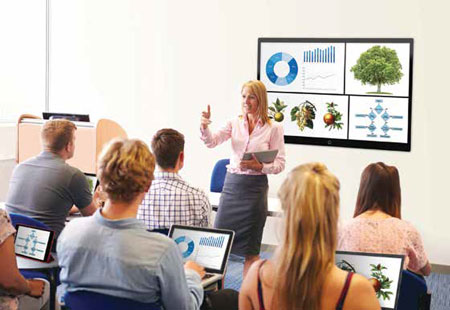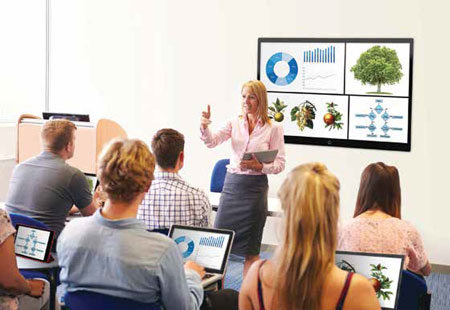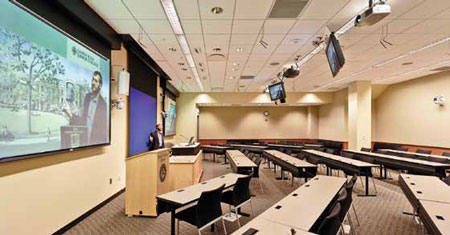AV Enables New Approaches to Education

Remember when the mere mention of classroom AV conjured up a vision of an AV presentation? Luckily, AV in higher education isn’t what it used to be.

Kramer’s VIA Campus allows students to log in to a single access point, then connect to everything from shared drives, to common files, to internet portals for content. “The biggest change is that it is no longer about presentation,” said Michael DiBella, director of collaborative solutions, Kramer Electronics USA. “It’s about AV collaboration. The content has become just as dynamic as the students in the classroom.”
When configuring a classroom today, one has to marry hardware elements, such as signal distribution, with software-based services, such as capture, content sharing, and workflow among other collaborative aspects, he noted.
And the collaboration needs to extend beyond the walls of the classroom. “Portals and open-source media need to be considered when designing a room,” DiBella explained. “It’s a level of connectivity that needs to be accommodated. That is why wireless connectivity with products like our VIA Campus has become so attractive. Students can log into a single access point, then connect to everything from shared drives, to common files, to internet portals for content.”
Another challenge, he cautioned, is in integrating these different needs and functions onto a single platform that is as easy to use as it is to control and manage. “Kramer strongly recommends looking at network-managed solutions, so you have a window into the hardware as well as the SaaS products being used. You can’t manage what you can’t measure.”
These important trends, such as learning initiatives like the flipped classroom, collaborative teams, and blended classrooms dramatically increase the amount of interactivity and flexibility. The traditional approaches to fixed-AV rooms just don’t apply.
“Learning spaces now involve teams of individuals that can form and disperse based on learning needs fairly quickly, and AV requirements need to be similarly flexible,” said Christopher Jaynes, founder and CTO, Mersive. “Displays that are mobile, to support different room configurations and team sizes are important and beg for a wireless sharing solution.”
A daily selection of the top stories for AV integrators, resellers and consultants. Sign up below.
With the mode and approaches of education changing rapidly, teaching is no longer constrained to a classroom, lecture, or even a college-ruled notebook, noted Scott McGarrigle, CTO, Utelogy. “Things are dynamic, interactive, connected, and the technology to support this new model needs to be, too. We know that smart classrooms—classrooms with technology, AV, and internet all integrated—enhance the learning experience. Faculties have continued to demonstrate that it really helps with student engagement, which leads to more student success.”
Go Configure
When classroom configuration was constrained by the AV systems that were being deployed, it was a tail-wagging-the-dog scenario, Jaynes said. “A large-screen display required all eyes up front, and a lectern next to that PC, embedded with AV controls seemed natural because the lecturer needed to stand where classroom attention was naturally focused.”
Now, wireless control and streaming can happen from the device that’s already in the pocket of the lecturer, and students can participate by sharing media to any number of displays that are deployed to support their team, study group, or presentation.
“AV installers and integrators can be far more creative in supporting the vision for learning in the space," he added. “As an example, we’ve seen our own product, Solstice, being deployed in Team Enabled Active Learning (TEAL) spaces, where each table has a private display for the students and the professor guides lectures by moving throughout the space and controlling the flow of different content sources on the displays using an iPad. Students can then share to any of the displays in the space simply by moving to a new table, connecting to the display, and publishing content.”
Of course, a wireless front end can support flexible student spaces while still being plugged into a more traditional back-end system. “Lecture-capture systems, in-room control panels, and video distribution for distance learning can be integrated into a more flexible classroom install,” Jaynes said. “For example, a wireless-enabled TEAL environment can be routed to overflow rooms, or even off-campus through software-based video distribution systems.
The trend toward flexibility isn’t predicated on revolutionary learning models, he noted. “Even in standard, more traditional presentation spaces, we’re seeing the use of local ‘confidence’ monitors deployed in larger, tiered classrooms. Those monitors can become collaborative work surfaces when the lecturer asks the audience to work among themselves.”

The classrooms of the future must be AV over IP-based to keep up with the trends in education, as this is the highway that allows interactive and collaborative learning and technology to take place, according to Scott McGarrigle, CTO, Utelogy.Near and Far
The best way to approach classroom AV design in this new model is to stop focusing on the room and take a student-centric point of view, McGarrigle advised. “When you do this, the role of the AV system goes far beyond just presentation, and needs to support a variety of scenarios.”
The most abundant of these is distance education, he noted, starting with the fact that not all students are in the same physical location. “This can be done through multiple classrooms with videoconferencing, or by having students join from wherever they are, via some webinartype of software. In any of these scenarios, the need is the same: to use data connectivity and technology to share and collaborate to multiple points, geographically dispersed.”
The best way to facilitate this is by converting the content into data, McGarrigle said. “Once in data form, this can be sent anywhere and forms the basis for the communication and collaboration of today’s teaching modalities. Not only can this data be sent to remote classrooms and individuals for display, it can also be sent to capture devices for recoding and later dissemination. There are a whole plethora of opportunities that spring forth, once you ‘go data’ and are digitized on the network.”
These classrooms of the future must be AV over IP-based to keep up with the trends in education, as this is the highway that allows interactive and collaborative learning and teaching to take place, he noted. “In addition to this, existing digital content can now be integrated. From media servers, to cloudbased repositories, to simply showing a YouTube video, networks and digital content are bringing everyone together.”
As classrooms provide that infrastructure and access to the digital content highway, the next important aspect is ensuring that highway is easy to use and navigate, and not just for teachers, McGarrigle said. “With flipped classrooms and interactive teaching modes, students are leading presentations and sharing their work via these same classroom AV technologies. Having the means to moderate classroom sessions by control and management, not only of the devices in the room but the flow and dissemination of content, is a key need. This necessitates the need for a smart control system approach for this digital content to be controlled and the classroom session to be orchestrated.
When you think about the different teaching modes that need to be implemented, classrooms should be configured to deliver the most flexibility possible, he concluded. “As you merge into AV over IP, you get all the flexibility of the network and all the reliability that’s been implemented in those networks. It’s really fundamental to enabling people to be effective and engage in different manners, especially in the classroom. Some faculty members want to be embedded with the students, and some want to be behind as they’re joining them in the presentation. As technology providers, we want to be in front of them enabling them to get the job done.”
Karen Mitchell is a freelance writer based in Boulder, CO.
